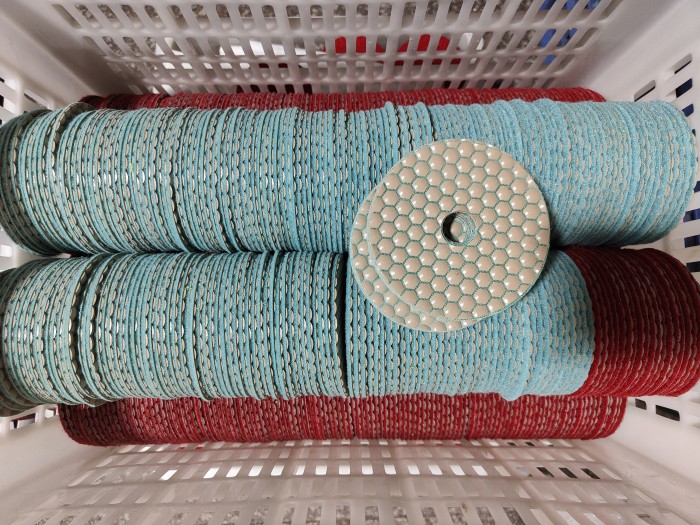
What are the storage requirements for diamond flexible polishing pad?
Diamond flexible polishing pads are essential tools for achieving high-quality finishes and precise polishing in a variety of industrial applications, including stone manufacturing, concrete polishing, and surface restoration. To ensure consistent performance and extend the life of these valuable tools, it is critical to adhere to correct storage practices. This article explores the environmental requirements and optimal storage conditions for diamond flexible polishing pads, highlighting key considerations to maintain their quality and effectiveness.

Storage environment requirements
The storage environment plays a critical role in maintaining the integrity and performance of diamond flexible polishing pads. Environmental factors such as humidity, temperature, and ventilation directly affect the condition of the pad. Therefore, these environmental requirements must be recognized and met to ensure the quality and service life of the polishing pad.
Dry environment: Keeping storage areas dry is critical to preventing polishing pads from absorbing moisture and forming condensation. Excessive moisture can cause the polishing pad backing material to deteriorate, compromising its structural integrity and polishing effectiveness. Additionally, exposure to moisture can cause metal components, such as the diamond particles embedded in the pad, to rust, reducing their abrasive performance.
Ventilation: Adequate ventilation of storage areas is critical to minimizing the build-up of stagnant air and the potential for moisture entrapment. Proper airflow helps reduce the risk of moisture build-up, which can adversely affect the surface quality and performance of flexible polishing pads. Effective ventilation also helps maintain a good storage environment by promoting air circulation and preventing the build-up of airborne contaminants that could compromise pad integrity.
Temperature Control: Controlling the temperature of your storage area is critical to preventing pads from being exposed to extreme heat or cold. High temperatures can cause polishing pads to deform, affecting flatness and overall performance during polishing operations. Conversely, exposure to extremely low temperatures may affect the flexibility and elasticity of the pad material, reducing its effectiveness in adapting to various surface contours. Therefore, maintaining moderate and stable temperatures in the storage environment is critical to maintaining the quality and functionality of diamond flexible polishing pads.
Optimal storage conditions
Choose a designated storage area that is free of excess moisture and contaminants. Regular cleaning and maintenance of storage spaces is critical to minimizing the presence of dust, dirt, and other particles that can compromise the cleanliness and condition of polishing pads. Utilize dehumidifiers or humidity control measures to maintain optimal humidity levels within storage areas. Implement temperature monitoring measures to ensure storage areas remain within recommended temperature ranges. Also, avoid exposing the pad to direct sunlight or strong heat sources to prevent thermal damage and deformation. Store diamond flexible polishing pads away from direct contact with floors or surfaces that may transmit moisture. Using elevated racks or pallets can help protect the pads from potential moisture absorption and contamination.
Effects of vibration and collision
When subjected to external vibration, the abrasive particles and bonded materials within the pad can be subjected to excessive stress, leading to premature wear and potential detachment. Additionally, collisions with other objects or surfaces can cause the polishing pad to deform, break, or become irregular, reducing its ability to provide consistent and precise polishing results. Therefore, prioritizing strategies to mitigate vibration and collision risks is critical to maintaining the quality and performance of these critical polishing tools.
When determining storage location, the following factors must be considered:
Vibration-free environment: Storage should be located away from sources of mechanical vibration, such as heavy machinery, industrial equipment, or areas with high operational activity. Avoiding these vibration-prone areas helps minimize the pad’s exposure to damaging forces that could compromise its structural integrity.
Anti-vibration pads and isolation frames: Installing anti-vibration pads or isolation frames within the storage area can help reduce the impact of external vibrations on the polishing pads. These specialized mechanisms are designed to absorb and dampen vibration, providing protective cushioning that helps protect the pad from potential damage.
Space management and filling: Make sure there is enough space between the polishing pads being stored and other objects or surfaces in the storage area. Maintaining adequate clearance helps prevent accidental collisions and minimizes the risk of the mat being struck by surrounding items. In order to reduce the possibility of collision, soft grinding discs of different specifications and models should be reasonably separated in the storage space.
Easy to manage and use
Effective management and use of diamond flexible polishing pads depend on clear and accurate identification within storage areas. Marking the size and model of the pad, as well as applying a visible label or logo, can simplify the process of locating and selecting the correct pad for a specific task. Not only does this save time, it also minimizes errors and confusion, thereby improving overall operational efficiency. With specifications and models clearly displayed, including key details such as grit size and expected surface type, users can quickly determine the polishing pad best suited for specific polishing requirements. Additionally, visible labels or logos make it easier for supervisors and operators to inventory and track pad usage, allowing for better resource allocation and management.
For diamond flexible polishing pads with a defined service life, paying attention to the production date becomes critical. Identifying the production date enables operators and supervisors to accurately monitor pad life and usage. This information is critical to ensuring that old polishing pads are not inadvertently pushed beyond their optimal performance, potentially resulting in poor polishing results or even damage to the surface being worked on. In addition, knowing the production date allows users to choose appropriate grinding discs based on their aging condition.
-
Online service
-
Official wechat
account
-
QQ:40933769
-
E-mail:
sales@z-lion.com
Online service
Please feel free to give your inquiry in the form below. We will reply you in 24 hours.

